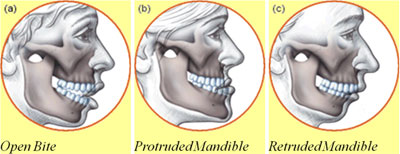Corrective Jaw surgery is performed by an Oral Surgeon to correct misalignment of jaws and teeth that cannot be treated with conventional Orthodontics. It is also referred to as Surgical Orthodontics. Corrective Jaw surgery improves chewing, swallowing, speech, breathing and facial appearance.
Who are candidates for Corrective Surgery?
Jaw growth is a slow and gradual process but in some individuals the upper and lower jaws grow at different rates causing wide range of jaw and facial irregularities that could lead to any of these problems:
 Common dento-facial abnormalities that can be corrected with Orthognathic Surgery
Common dento-facial abnormalities that can be corrected with Orthognathic Surgery
Injury to the jaws or birth defects can also affect the alignment of the jaws. If you have any of these conditions due to irregular jaw growth your dentist, orthodontist and Oral and Maxillofacial Surgeon will work together to determine whether you are a candidate for corrective jaw, or orthognathic surgery.
What is involved in the procedure?
Your oral surgeon will determine the type of orthognathic surgery. Your treatment will probably include orthodontics before and after surgery and may take several years to complete. Corrective jaw surgery may reposition all or part of the upper jaw, lower jaw and chin.
Before your surgery, orthodontic braces move the teeth into a new position, which at first might look like the condition is getting worse. However, when your Oral and Maxillofacial Surgeon repositions your jaws during surgery, your teeth should fit together properly.
As your pre-surgical orthodontic treatment nears completion, additional or updated records, including x-rays, pictures and models of your teeth, may be taken to help guide your surgery.
Depending on the procedure, corrective jaw surgery may be performed under general anesthesia in a hospital, an ambulatory surgical center or in the oral and maxillofacial surgery office. Surgery may take from one to several hours to complete.
Your Oral and Maxillofacial Surgeon will reposition the jawbones in accordance with your specific needs. In some cases, bone may be added, taken away or reshaped. Surgical plates, screws, wires and rubber bands may be used to hold your jaws in their new positions. Incisions are usually made inside the mouth to reduce visible scarring; however, some cases do require small incisions outside of the mouth. When this is necessary, care is taken to minimize their appearance.
After surgery, your surgeon will provide instructions for a modified diet, which may include solids and liquids, as well as a schedule for transitioning to a normal diet. You may also be asked to refrain from using tobacco products and avoid strenuous physical activity.
Pain following corrective jaw surgery is easily controlled with medication and patients are generally able to return to work or school from one to three weeks after surgery, depending on how they are feeling. While the initial healing phase is about six weeks, complete healing of the jaws takes between nine and 12 months.
Although the goal of this surgery is to improve your bite and function and move your teeth and jaws into a balanced and healthy position some patients also experience enhancements to their appearance and speech.
| Monday | 8:30 AM | 4:30 PM |
| Tuesday | 8:30 AM | 4:30 PM |
| Wednesday | 8:30 AM | 4:30 PM |
| Thursday | 8:30 AM | 4:30 PM |
| Friday | 8:00 AM | 2:00 PM |
| Saturday | Closed | |
| Sunday | Closed | |
Accessibility Menu